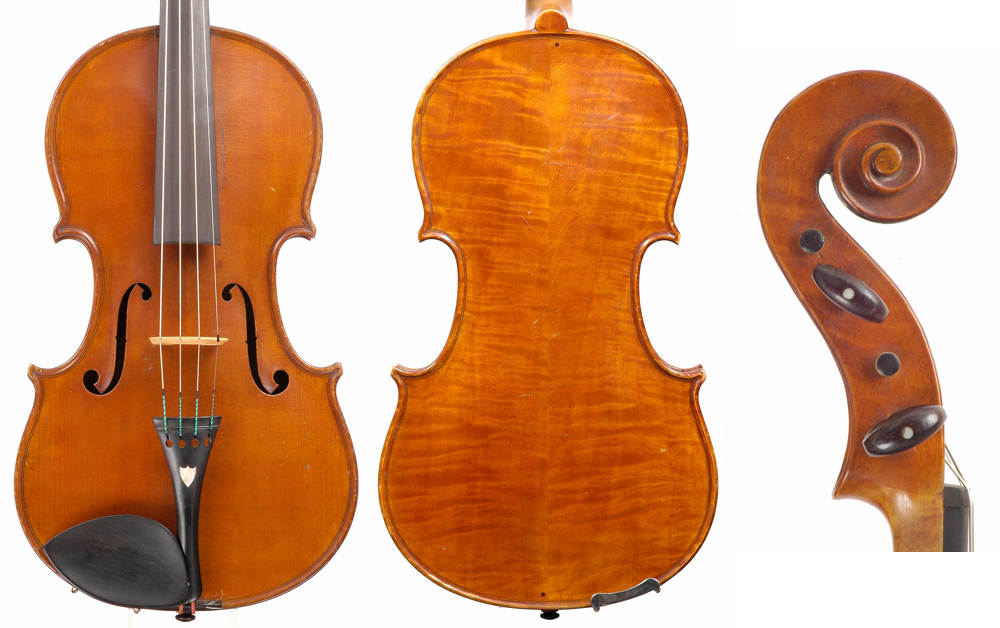Alfred Eugene Lanini was born on January 19, 1891 in Gonzales, California. His parents, John and Carmella Lanini, were immigrants from the Italian section of Switzerland. According to living descendants of the family, young Alfred took an early interest in the violin, starting lessons aged 12. In 1908 the Lanini family relocated from Gonzales to San Jose, California, about 75 miles to the north. Here, Alfred Lanini eventually met a retired doctor and amateur violin maker, Dr Walter Hill, and worked with him for a short time before traveling to Milan in 1911 to study with Riccardo Antoniazzi.
A key figure in the success of the Leandro Bisiach enterprise, Antoniazzi was one of the leaders of the resurgence in Italian violin making in the last quarter of the 19th century, making him a likely choice of a mentor and teacher for Lanini (see our feature on the Antoniazzi brothers). The Lanini family had emigrated from the village of Frasco, less than a hundred miles from Milan, a place within the political borders of Switzerland, but every bit Italian nonetheless. Inquiries of family or friends in the old country would have naturally led an apprentice seeking a potential master to Riccardo Antoniazzi, one of the most famous makers in Italy at the time.
Lanini’s apprenticeship with Antoniazzi wound up being brief: Antoniazzi died on November 10, 1912, less than six months after Lanini’s arrival in Milan. Lanini was then taken in by another important Milanese maker of the period, Celeste Farotti. That apprenticeship lasted until 1914, when Alfred returned to San Jose. Lanini and Farotti apparently parted on the best of terms. Of Lanini, Farotti wrote: ‘This young man spoke little and kept himself to himself. He rarely went out if not with me. He was like a lamb: I taught him what I knew with much affection and before a year had gone by he had learned to make very nice instruments – violins, violas and violoncellos. He worked very well and I was glad to have had such a good student.’ [1]
From the beginning of his career in Italy, Lanini appears to have been in full command of his tools, building neat and refined instruments. Examples of Lanini’s work from his early period in Italy are rare, but from what we have seen we can make the following observations:
The work closely follows the stylistic models and technical methodology of his masters, Antoniazzi and Farotti, each of whose influence can be detected in various Lanini instruments. Typically these early examples have purling that is narrow and even, set relatively close to the edge, forming a delicate and manicured margin. The purfling mitres point straight into the corners in the manner of the early 20th-century Milanese school. The arching is slightly full and scooped stylishly at the edges. The scrolls are refined and deeply carved, forming a delicate bevel on the edges. The wings of the f-holes are skilfully fluted and the work is marked by an overall lightness that is mostly absent in Lanini instruments after this period. The varnish is skilfully applied and varies from a thin yellow-brown, reminiscent of Romeo Antoniazzi, to a thicker, dark red varnish more like that of Farotti.
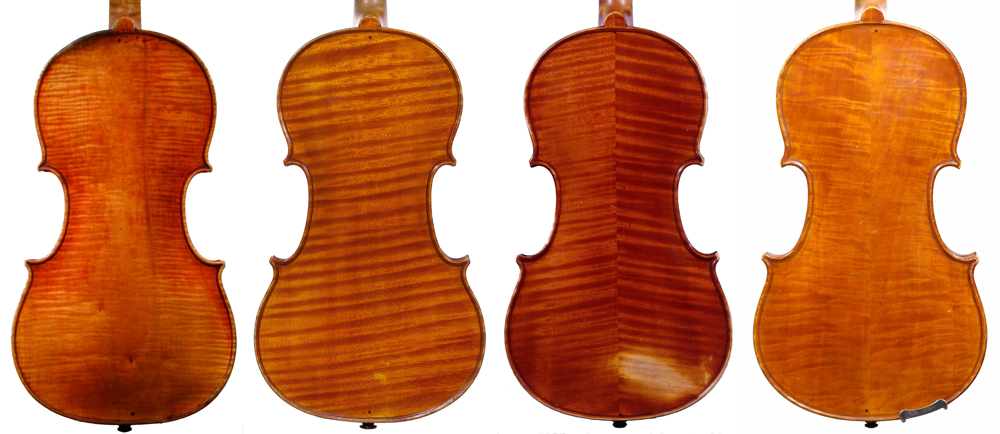
Influences on Milanese violin making (left to right): violins by G.B. Ceruti, Riccardo Antoniazzi, Celeste Farotti and Alfred Lanini
Early Lanini instruments are unbranded and some of the distinctive quirks that appear on the maker’s later work are understated or missing altogether. As a result, some of the early Lanini output can easily pass for the work of the Antoniazzi atelier while other examples might be confused with the work of Farotti’s nephew, Celestino. One specific stylistic difference between the work of Lanini, Antoniazzi and Farotti is in how the heel of the neck is shaped where it joins the back. Whereas Farotti often crafts a tall and vertically elongated button, with elegant nicks on either side, Antoniazzi usually forms a lower, shorter button with smallish nicks. Lanini buttons are almost always carved in an even lower, somewhat squat shape with very pronounced nicks that become even more pronounced through his life. Unlike much of the work of Farotti, Lanini does not normally pick the chamfer of the scroll out in black in the manner of Stradivari, imitated by makers in Turin and elsewhere.
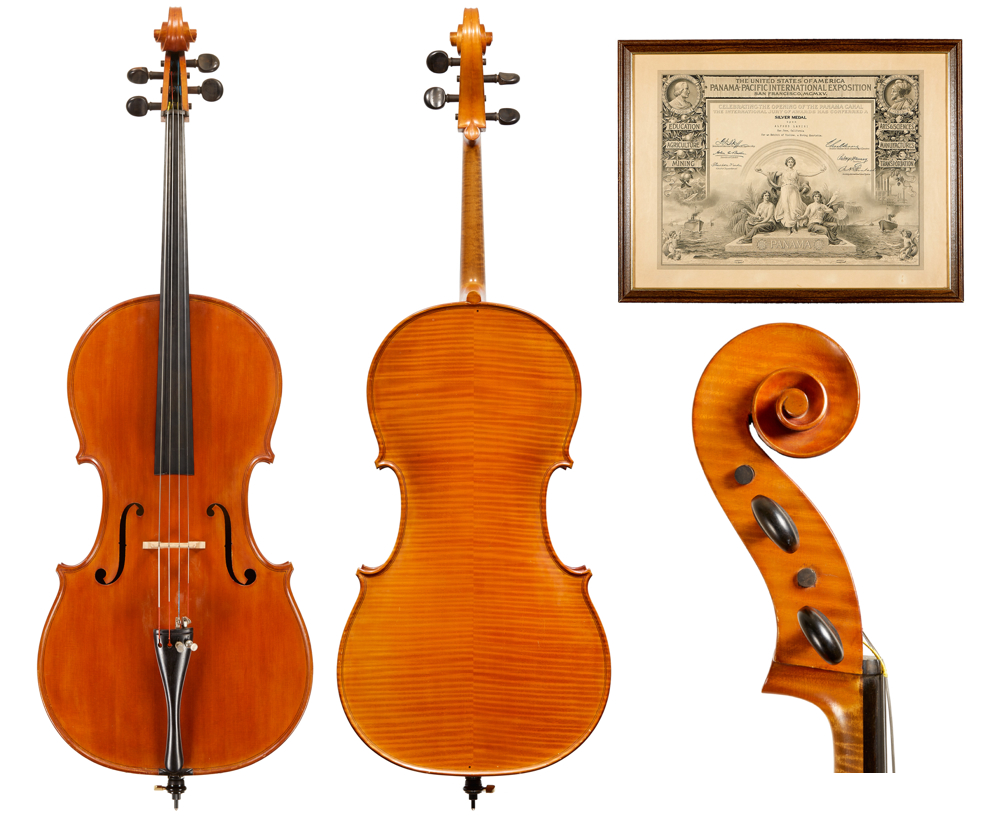
The cello from the string quartet that won Lanini a silver medal in the Panama-Pacific International Exposition, San Francisco 1915
Instruments from Lanini’s Italian period are labeled: ‘Alfredo Lanini, allievo di Riccardo Antoniazzi, di Cremona, fece a Milano 1912.’ His early works show a high level of achievement and their construction details follow the general Milanese concept from the turn of the 20th century, the antecedents of which can be traced to G.B. Ceruti.
After his return to California in 1914, Lanini attended and graduated from the King Conservatory in San Jose (eventually absorbed by the University of the Pacific). In 1915 Celeste Farotti was awarded ‘the diploma of the medal of honour’ at the Panama Pacific International Exhibition San Francisco, having likely visited California at the invitation of the Lanini family. Lanini exhibited a quartet at the same event, which was organized in part to commemorate the opening of the Panama Canal the year before.
Instruments from after Lanini’s return to California show a heavier style than is seen on his Italian period instruments. The purfling is made with a wide middle strip and the thickly beaded edges are formed into large square corners. The varnish varies from orange to red in color and is often made from linseed oil. Occasionally one finds linseed oil thickly applied to the interior surfaces of instruments. Post-Italy Lanini instruments are normally branded ‘A.LANINI’ or occasionally ‘A. LANINI, CAL.’ on the bottom rib below the button, and very often on the table underneath the fingerboard near the neck. Brands also frequently appear inside the instruments on the back and on the blocks, sometimes in many places.
While not absolutely consistent, other features of Lanini instruments made after his return to the US include a less precise hollowing out of the bottom f-hole wings, and scrolls that appear somewhat awkward in profile, but always show a personal style with strongly fluted back volutes. The backs are usually of high-quality quarter or slab-cut maple while the tops are of spruce, sometimes of a wider grain than is considered optimal. The backs are usually pinned in the Antoniazzi style with ebony pins at both the top and bottom. (Paradoxically this feature is not consistently found on instruments from Lanini’s Milanese period.) For the instruments made with two-piece backs the top pin is normally on the bass side of the instrument while the bottom is normally on the treble side, which is the opposite of the more typical positioning found on Riccardo Antoniazzi instruments. The pronounced nicks on either side of the button seen in Lanini’s Milanese instruments morph in his work in San Jose into deep knife cuts along the base of the button, extending into a shallow area across the button. This signature feature can be observed consistently on Lanini instruments from his return to the US through to the end of his life.
In 1916 Lanini married Arma B. Lober of Monterey, California in a union that was to produce three sons: Paul (1917–1985), Donald (1923–1945) and Henry (1926–2002). The following year Lanini established his business in San Francisco, but the failing health of his father forced him to return to San Jose after only six months. Back in San Jose, Lanini moved into a building at 591 East St James Street that he had purchased in 1914. This building had formerly housed the workshop of the noted violin maker A.W. Kaufmann.
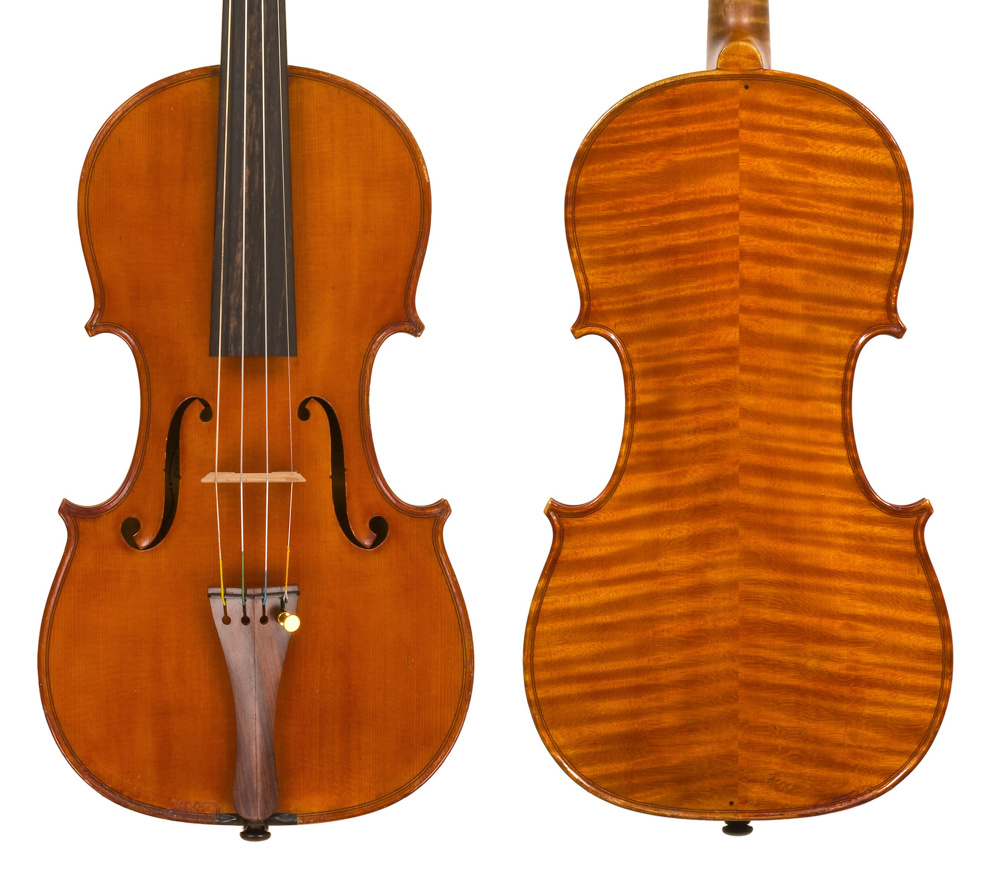
Lanini violin made in San Jose, 1925. His instruments from the 1920s and 30s represent the best of his American output
During the 1920s Lanini was less prolific. The limited production at this time may stem in part from his developing interest in bow making. Lanini studied bow making first with August Nurnberger-Suess (1875–1944) of Novato, California, and then in 1928 he traveled to Europe to study with Auguste Husson in Paris. Lanini bows are normally branded ‘A. Lanini’ and crafted on a swan-head design. According to the bow maker John Bolander, who later learned bow making from Lanini and worked with him for many years, Lanini’s struggle with asthma caused him to retreat from bow making, which would account for the scarcity of Lanini bows.
Towards the end of 1928 Lanini returned to San Jose and again relocated his shop, buying a spacious building at 180 South 3rd Street. The output from this period is limited but does include some very fine and interesting instruments. In addition to a few fractional violins, possibly built for his own children, there are some violins that have a more refined look than those of the 1915–1920 period. With purfling mitres that point straight toward the center of squared-off corners, somewhat lighter edgework and a transparent varnish, these instruments continue to represent the traditions acquired by Lanini in Milan. The instruments from the 1920s and 1930s represent the best of Lanini’s American output.
In 1931 John Bolander and his son, John Bolander Jr, joined Lanini in the workshop at South 3rd Street in an arrangement that was to serve all well. Bolander Sr was responsible for violin repairs and Bolander Junior worked on band instruments. In 1932 Lanini asked Bolander Jr if he would be interested in learning to make bows but it wasn’t until 1943 that Bolander Jr made the commitment to devote himself to bow making under Lanini’s tutorship. [2] Bolander lived in a small building behind the Lanini shop for many years as he developed his bow making skills.
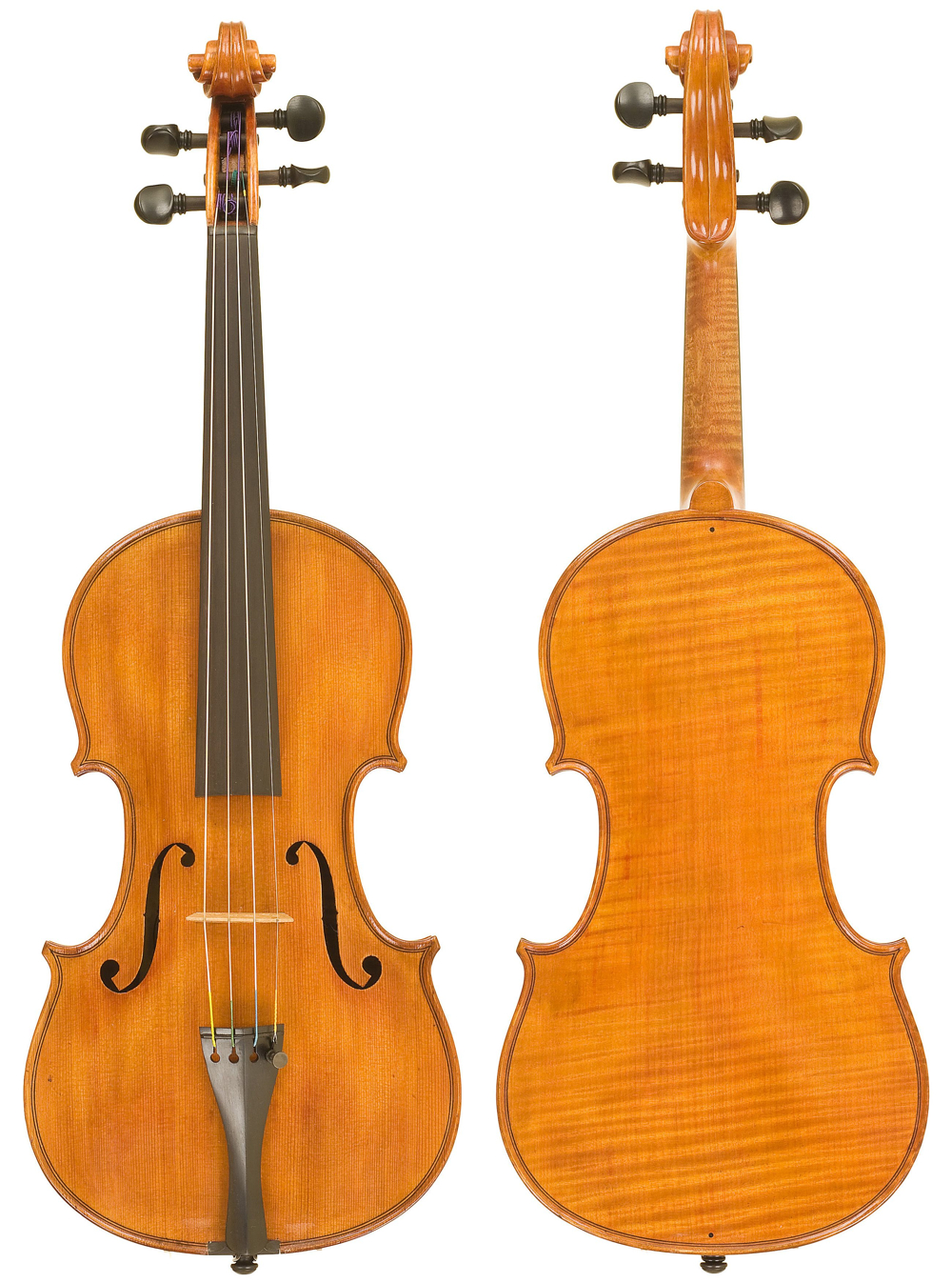
Lanini violin made in San Jose, 1936; from this point his work begins to depart stylistically from his Milanese training, perhaps due to his studies of classic Cremonese instruments
In the 1930s Lanini was back at the bench in earnest, producing a number of fine instruments which (like the instruments from the 1920s) display his admirable artistic capabilities and evolving sensibilities. By the middle of the decade the work increasingly begins to reflect a stylistic departure from some the aspects of his Milanese training. Most noticeably, it is at this point that Lanini begins to sharply deflect the purling mitres into the corners, in the manner of Stradivari, and distinct from the tradition in which he was trained. Whether or not the stylistic evolution of Lanini’s work in this period is attributable to his study of classic Cremonese instruments remains unconfirmed, but in 1940 Lanini acquired an Omobono Stradivari violin. Clearly his interest in classic violins was more than passing, as in 1943 he acquired another Stradivari, the 1727 ‘ex Gillott’ violin. Whatever the cause, some of the changes seen in Lanini’s work from the mid-1930s were to remain with him through the end of his life.
Lanini remained prolific through the 1940s. While many instruments from this period exist, a decline in the standard and individuality of his work is increasingly apparent in these later years through to the end of his life in 1956. Distinctive characteristics that had given earlier examples personality become exaggerated and the overall quality of the workmanship betrays an older hand. The handling of the edgework is generally less precise; the fluting of the bottom f-hole wings is at times practically nonexistent; and the varnish becomes less transparent overall, with color tending towards shades of dull, opaque yellow and green. The scrolls, however, appear generally the same, slightly larger, but with the pronounced fluting and distinctive awkwardness associated with the earlier, post-Italian examples.
Students of Alfred Lanini
As well as teaching John Bolander bow making, Lanini taught violin making to his two sons, Paul and Henry and also Carol Weston. When Lanini died in 1956, his son Henry took over the shop and continued the work until his death in 2003. Paul is also known to have continued the family tradition of violin making but we have not seen any Paul Lanini instruments. Neither Henry nor Paul were prolific makers.
Julian and Stefan Hersh are performers, experts and co-founders of Darnton & Hersh Fine Violins in Chicago.
To mark the publication of the new American Violin book by the AFVBM, next week we will feature the Gemünder family of violin makers.
Notes
[1] Giovanni Iviglia, Celeste Farotti – ‘Portrait of a Violin Maker’, A. Salvioni, 1953
[2] John Bolander, Journal of the Violin Society of America, Vol. IV no. 2, 1979
